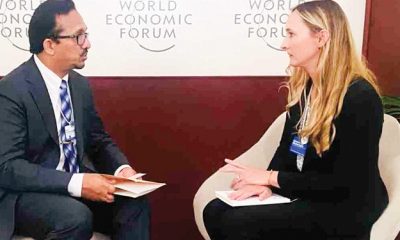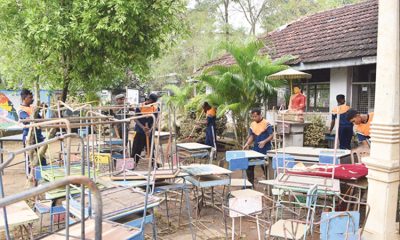Business
Revised External Sector Performance – February 2022

The momentum of export earnings continued with over US dollars 1.0 billion for the ninth consecutive month in February 2022.Meanwhile, import expenditure also increased substantially in February 2022, year-on-year, while recording a decline, compared to the previous month. The trade deficit widened, compared to year before. Tourist arrivals showed a notable recovery in February 2022 over the same month in the previous year. Workers’ remittances continued to moderate in February 2022. Foreign investment in the Colombo Stock Exchange (CSE) recorded a net inflow during the month. The weighted average spot exchange rate in the interbank market hovered around Rs. 202 per US dollar during February 2022.
However, the Central Bank allowed a measured adjustment in the exchange rate in the first week of March 2022, in view of the heightened pressures on the exchange rate amidst subdued liquidity in the domestic foreign exchange market, resulting in an overshoot subsequently by market forces beyond the expected level of depreciation in the measured adjustment.
Merchandise Trade Balance and Terms of Trade
Trade Balance: The deficit in the trade account widened to US dollars 781 million in February 2022, compared to the deficit of US dollars 572 million recorded in February 2021. However, on a month-on-month basis, the trade deficit declined in February 2022 from US dollars 859 million recorded in January 2022. Meanwhile, the cumulative deficit in the trade account during January to February 2022 widened to US dollars 1,640 million from US dollars 1,227 million recorded over the same period in 2021. The major contributory factors of the trade deficit are shown in Figure 1.
Terms of Trade: Terms of trade, i.e., the ratio of the price of exports to the price of imports, deteriorated by 10.7 per cent in February 2022, compared to February 2021, as the increase in import prices surpassed the increase in export prices.
Performance of Merchandise Exports
Overall exports: Earnings from merchandise exports in February 2022 grew by 14.7 per cent over February 2021, recording at US dollars 1,092 million. An increase in earnings was observed in industrial exports and mineral exports, while a decrease was observed in agricultural exports. The cumulative export earnings, which increased by 16.1 per cent during January-February 2022 over the same period of the last year, amounted to US dollars 2,192 million.Industrial exports: Earnings from the export of industrial goods increased in February 2022 by 19.4 per cent, compared to February 2021. This increase was due to a broad-based increase in earnings from most of the industrial products led mainly by garments and petroleum products. Export of garments to all major markets improved.
Earnings from the export of petroleum products increased due to the increase in both prices and volumes of bunker and aviation fuel exports. Further, a sizable increase was recorded in the exports of food, beverages and tobacco (mainly manufactured tobacco, chocolate and liquid coconut milk), base metals and articles (mainly tools and aluminium structures), rubber products (mainly solid tires and surgical rubber gloves), gems, diamonds and jewellery, machinery and mechanical appliances (mainly mechanical appliances parts and electric conductors).However, a marginal decline in earnings was reported in the categories of Personal Protective Equipment (PPE), such as face masks categorised under made up textile articles, and plastic clothing articles categorised under plastics and articles, reflecting the decline in demand for such items.
Agricultural exports: Total earnings from the exports of agricultural goods in February 2022 declined by 2.1 per cent, compared to February 2021, due to the decrease in export earnings from tea, spices and unmanufactured tobacco. The drop in export earnings from tea by 10.4 per cent (y-o-y) was mainly due to lower export volumes (a decline of 9.1 per cent), while average export prices (a decline of 1.4 per cent) also partly contributed to this decline. Earnings from spices declined by 18.3 per cent (y-o-y) in February 2022 due to lower export volumes of cloves, cinnamon and nutmeg.Adverse weather conditions and the shortage of chemical fertiliser were the main reasons for the decline in export volumes of agricultural products in general. However, the export sub categories of sea food (primarily fresh and frozen tunas), coconut (primarily fibres and desiccated coconut), natural rubber, minor agricultural products and vegetables recorded an increase in February 2022, compared to the previous year.
Mineral exports: Earnings from mineral exports increased by 12.7 per cent in February 2022, compared to February 2021, due to higher earnings from quartz, titanium ores and granite.Export indices: The export volume and unit value indices increased by 11.2 per cent (driven by industrial exports) and 3.1 per cent respectively, (y-o-y), in February 2022, indicating higher export volumes contributed more to the increase in export earnings.
Performance of Merchandise Imports
Overall imports: Expenditure on merchandise imports increased by 22.9 per cent to US dollars 1,873 million in February 2022, compared to US dollars 1,524 million recorded in February 2021, while recording a decline, compared to December 2021 and January 2022. An increase in expenditure was observed across all main categories, with intermediate goods imports contributing mainly to the expansion. On a cumulative basis, total import expenditure amounted to US dollars 3,832 million during the period from January to February 2022, recording an increase of 23.0 per cent, compared to US dollars 3,115 million recorded in the corresponding period in 2021.
Consumer goods: Expenditure on the importation of consumer goods increased in February 2022 by 9.5 per cent over the month of February 2021, driven by the increase in expenditure on food and beverages although expenditure on non-food consumer goods recorded a decline. Import expenditure on food and beverages increased by 22.5 per cent (y-o-y), mainly owing to the importation of cereals and milling industry products (primarily rice). Further, an increase in import expenditure was observed in spices (mainly chilies), vegetables (mainly big onions and potatoes), seafood (mainly dried fish), and beverages, while due to low import volumes the import expenditure of oils and fats (mainly coconut oil), sugar and dairy products (mainly milk powder) decreased.
Business
Birthday gift turned lifeline: US-based young environmentalist steps up for Sri Lanka

For Daham Perera, a December birthday celebration this year became something far more meaningful than cake, candles or gatherings with friends. Instead, it turned into a deeply personal act of solidarity with a country he calls his motherland.
Perera, a young environmental enthusiast based in Los Angeles, says his bond with Sri Lanka remains unbroken despite living thousands of miles away. “Although I live in America, my parents and all my relatives live in beautiful Sri Lanka. That connection is something I carry with me every day, he said.
Having visited Sri Lanka in August, Perera spent weeks traveling across the island, reconnecting with relatives and visiting historical and environmentally significant sites. “I saw the true beauty of Sri Lanka – its people, its biodiversity, and its rich heritage. Those memories are among the most beautiful in my life, he recalled.
That joy, however, was short-lived. Soon after his return, the devastating Ditwah cyclone struck the island, leaving a trail of destruction. Homes were damaged, livelihoods disrupted and families displaced. “When I saw images of my friends losing their homes, books soaked in mud, clothes ruined by floodwaters, I felt a pain I cannot put into words, Perera said.
As an environmentalist, the damage to Sri Lanka’s fragile ecosystems troubled him deeply. “Sri Lanka’s biodiversity is priceless. When disasters like this strike, it is not just people who suffer, but forests, wildlife and entire ecosystems that take years to recover, he noted.
With his birthday falling on December 9, Perera made an unconventional decision. “Normally, my father and I celebrate our birthdays by going to the temple and spending time with friends. But this year, celebrating didn’t feel right when my people were suffering, he explained. “I kept asking myself—what can I do, even from afar?”
The answer was simple but powerful. Perera chose to donate all the money he had saved for his birthday celebrations, along with additional contributions from his family, towards relief efforts in Sri Lanka. “Economic support at times like this is critical. Even a small contribution can help a family rebuild, restart a livelihood, or regain dignity, he said.
The donation was formally handed over to Sri Lanka’s Consul General in Los Angeles, Charith Yattegoda, at the Consulate premises. For Perera, the gesture carried deep emotional significance. “If I can replace my personal happiness with smiles on the faces of people back home, that is the most beautiful birthday I could ever celebrate, he reflected.
He describes the letter of appreciation he received in return as his most treasured gift. “That thank-you letter is not just paper. It is a reminder that loving your country means standing by it in its darkest moments. It will always remain one of the most meaningful keepsakes of my life, Perera said.
Perera hopes his story will inspire other young Sri Lankans living overseas to stay connected and give back. “Distance should never weaken our responsibility. Supporting Sri Lanka—its people, its economy, and its environment—is something we can all do, no matter where we live, he added.
In turning a birthday into an act of compassion, Daham Perera has offered a quiet but powerful reminder: sometimes, the greatest gifts are the ones we give away.
By Ifham Nizam
Business
John Keells Foundation partners Sri Lanka Police in combatting violence against women and children

As part of its ongoing commitment to combat violence against women and children towards empowering a healthy and progressive nation, John Keells Foundation (JKF) continues to empower law enforcement agencies through Project WAVE (Working Against Violence through Education) – its flagship of over ten years – to combat gender-based violence and child abuse.
These activities include a strategic collaboration through which JKF supported the Sri Lanka Police to enhance their response to crimes involving women and children through the sponsorship of a global cutting-edge investigative software for use in the Cyber Investigation Unit (CIU) at the Bureau for the Prevention and Investigation of Abuse of Children and Women (BPIACW). The software enables officers to analyse and connect data efficiently, strengthening their ability to investigate and prevent online exploitation and related offences. BPIACW reported that the new platform had directly contributed to a significant and measurable improvement in their investigative capacity, recording the rescue of 22 children, the arrest of 21 suspects, and the filing of 111 cases in courts within the first year of its deployment.
Speaking on the partnership with JKF, Deputy Inspector General of Police – Ratnapura, and Former DIG – Children & Women Abuse Prevention 8 Investigation Range, Renuka Jayasundara said, “We extend our sincere gratitude to JKF for your steadfast partnership and for serving as a cornerstone of our efforts to strengthen child protection services through Project WAVE. Your contribution is making a tangible and quantifiable difference as evidenced by the growing numbers of successful investigations and legal referrals.”
Beyond technological support, JKF has also conducted a series of Train-the-Trainer (ToT) programmes, to improve the ability of officers to respond to GBV and CP in a sensitive and effective manner. The sixth such ToT was conducted from 24th to 26th of September 2025 for the benefit of nominated officers of the Homagama, Kaduwela and Maharagama police divisions. To date, 162 officers across 60 police stations have been impacted.
Business
SLANZBC appreciative of help from Australia and New Zealand

The Sri Lanka Australia–New Zealand Business Council (SLANZBC) has extended its profound gratitude to both the Australian and New Zealand governments for the generous and timely assistance provided to Sri Lanka during the recent flood devastation.
Chandana Amaradasa, SLANZBC president, noted that both governments donated one million dollars each, in their respective currencies, at a critical moment for Sri Lanka — support that will play a significant role in helping communities rebuild their livelihoods.
The government of New Zealand has pledged NZ$1 million to support humanitarian relief efforts in Sri Lanka following Cyclone Ditwah.
This assistance will be channeled through an international
humanitarian partner to strengthen ongoing rescue and relief operations.
Similarly, the Australian government announced on November 30, 2025 that it will provide AUD 1 million in humanitarian aid to bolster Sri Lanka’s response to Cyclone Ditwah.
These compassionate and timely gestures, Amaradasa said, once again demonstrate the unwavering commitment of both countries to stand beside the Sri Lankan people in times of crisis. He also recalled that
Australia and New Zealand have consistently supported Sri Lanka, stepping forward during previous national emergencies as well.
Today’s humanitarian assistance further reaffirms the depth of these longstanding relationships and the true spirit of friendship that binds the nations — a bond built on mutual respect, shared values and enduring goodwill.
“Our association deeply appreciates this kind and meaningful support and remains committed to fostering even closer ties between the people of Sri Lanka, New Zealand, and Australia, he added.
By Hiran H Senewiratne
-

 Features7 days ago
Features7 days agoFinally, Mahinda Yapa sets the record straight
-

 Features7 days ago
Features7 days agoHandunnetti and Colonial Shackles of English in Sri Lanka
-

 Business5 days ago
Business5 days agoCabinet approves establishment of two 50 MW wind power stations in Mullikulum, Mannar region
-

 News6 days ago
News6 days agoGota ordered to give court evidence of life threats
-

 Features6 days ago
Features6 days agoCliff and Hank recreate golden era of ‘The Young Ones’
-

 Features6 days ago
Features6 days agoSri Lanka and Global Climate Emergency: Lessons of Cyclone Ditwah
-

 Opinion7 days ago
Opinion7 days agoA national post-cyclone reflection period?
-

 Latest News6 days ago
Latest News6 days agoSri Lanka squad named for ACC Men’s U19 Asia Cup













